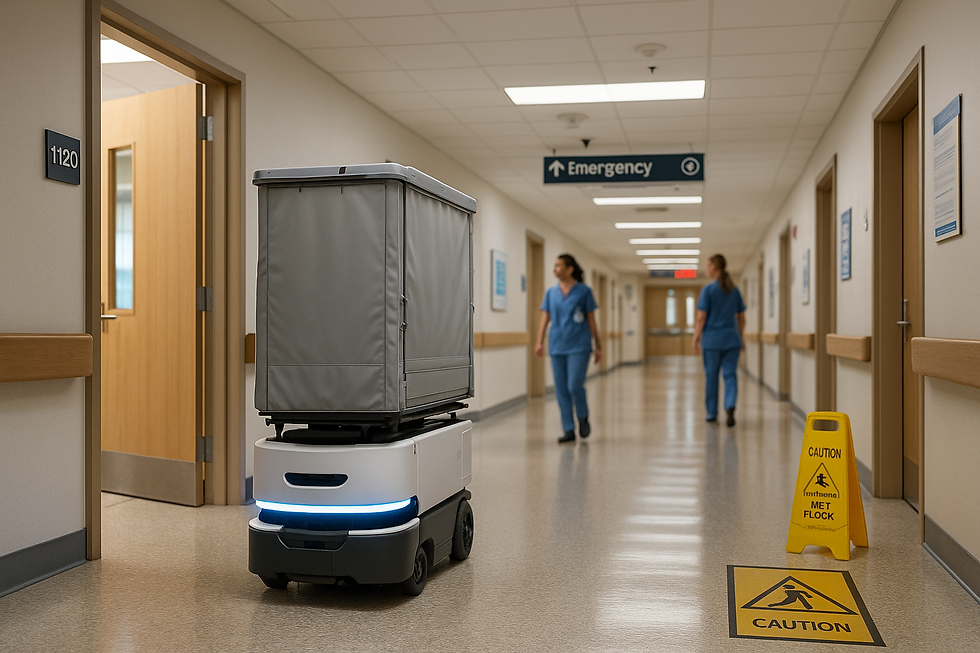Safer, Cleaner, On-Time: How Automated Cleaning and Robotic Transport Help Hospitals & Retirement Communities Right Now
- John Stikes

- Jul 31
- 4 min read

Care teams are stretched thin. Environmental services (EVS) and non-clinical transport (meals, linens, meds, waste) compete with resident and patient time, and cluttered hallways make both safety and surveys harder. Two proven levers—automated cleaning and robotic transport of goods—can relieve pressure without asking people to sprint faster. The industry evidence is clear on the why and how.
Why this matters now
Workforce constraints are structural. Health systems expect persistent staffing challenges into 2025; the latest AHA Workforce Scan compiles the trend and practical responses (upskilling, role redesign, automation where it removes low-value work). American Hospital Association+1
Cleanliness and compliance are non-negotiable. CDC’s environmental-services guidance lays out what “good” looks like (clean → disinfect → verify) and how to operationalize it consistently across units and care types. CDC
Corridor clutter is a safety and survey risk. Joint Commission FAQs state egress corridors can’t be used for storage; wheeled items in use must be moved promptly—so predictable, logged delivery flows matter. Joint Commission+1
What “good” looks like in hospitals and retirement homes
Automated, auditable cleaning (EVS)
Build SOPs straight from CDC Environmental Services: define the surfaces, approved products, contact times, and verification methods. For pathogens covered by federal guidance, select products from EPA List N and use them per label. Keep electronic logs. CDCUS EPA
Use adjunct technologies—like UV-C or autonomous scrubbers—after manual cleaning to improve consistency for large public areas (lobbies, dining, activity rooms) or terminal turns. Treat them as additions to, not replacements for, core EVS practice. (CDC guidance emphasizes programmatic cleaning and verification; adjuncts fit inside that framework.) CDC
Publish a weekly “clean ops” report: area coverage %, product contact-time compliance, near-misses/slips, and minutes saved by automation—so Infection Prevention, EVS leadership, and administrators see the same metrics.
Robotic transport of goods (meals, linens, meds, lab, waste)
Internal-delivery robots (e.g., TUG-class) can tow or carry closed carts for soiled linen, waste, meals, and supplies—freeing staff for resident interaction and bedside care. More than 100 U.S. hospitals run these fleets; Froedtert Hospital’s program is a recent, well-documented example. Froedtert Medical CollegeHFM Magazine
Standardize routes and add elevator/badge integration so runs are predictable and logged. Predictability keeps corridors clear, aligns with egress expectations, and reduces “hallway parking.” Joint Commission
Design jobs with people in mind. OSHA’s hospital housekeeping guidance spotlights musculoskeletal risk from pushing/pulling heavy carts—exactly the work robotic tugs and scheduled runs relieve. OSHA+1

What changes in daily life—for staff and residents
Fewer interruptions, more face time. When robots handle routine runs and EVS is scheduled and logged, nurses and aides spend more time with residents, and EVS techs spend more time where their judgment matters. (Hospitals that deploy delivery robots consistently frame them as staff supplements, not replacements.) HFM MagazineWIRED
Cleaner, clearer hallways. Predictable runs reduce “just park it here” moments; Joint Commission’s egress rules are easier to meet when carts move on a clock. Joint Commission
Better experience measures. Audited EVS and quieter, uncluttered corridors support patient/resident experience scores tied to cleanliness and quiet.
A practical 90-day plan (you can copy this)
Days 0–15 — Baseline & design
Time-and-motion: map two high-traffic runs (e.g., meals and soiled linen) and one public-area cleaning zone.
Draft CDC-aligned EVS SOPs: surfaces, products, contact times, verification method; select List N products where applicable. CDCUS EPA
Identify egress pinch points and storage “hot spots” to eliminate with scheduled runs. Joint Commission
Days 16–60 — Pilot & instrument
Pilot 1–2 robotic routes with closed carts (e.g., breakfast trays + soiled linen return). Add elevator/badge integration and call buttons. Froedtert Medical College
Launch autonomous scrubber passes for one lobby/corridor block; keep manual detail work for edges and touch points (document both). CDC
Start weekly reporting: on-time deliveries, corridor-clearance checks, EVS contact-time compliance, near-misses, minutes saved.
Days 61–90 — Decide & scale
Compare to baseline; quantify minutes returned to care and EVS, and corridor-clutter reductions (photo audits + spot checks).
Approve scale kit: fixed routes, elevator rules, SOPs, training, and incident response; commit to 2–3 additional routes/zones.
Guardrails and governance (to keep everyone comfortable)
Safety & egress: Mark crossings and park zones; publish “quiet hours.” Keep egress corridors free of storage; ensure “in-use” wheeled items move within the allowed window. Joint Commission
Cleaning integrity: Treat autonomy and UV-C as adjuncts; never bypass product label instructions or contact times. Use CDC EVS guidance and List N as your north stars. CDCUS EPA
Change management: Co-design routes and schedules with aides, nurses, and EVS techs; train on handoffs, exceptions, and elevator behavior. Track ergonomics outcomes (injury reports, push/pull forces) to show the human benefit. OSHA
What we deliver
Route & duty-cycle design for robotic transport (meals, linens, meds, waste) with elevator/badge integration and proof-of-delivery. Froedtert Medical College
CDC-aligned EVS program with electronic logs, contact-time tracking, and optional adjunct technologies where justified. CDC
Audit-ready package: egress compliance checklist, SOPs, training records, and weekly dashboards your leaders can use in QA and surveys. Joint Commission
Sources & further reading
AHA — 2025 Health Care Workforce Scan (full + executive summary). American Hospital Association+1
CDC — Environmental Services (cleaning & disinfection program guidance). CDC
EPA — About List N (EPA-registered disinfectants and proper use). US EPA
Joint Commission — Egress corridor storage/clutter FAQs. Joint Commission+1
Froedtert Hospital & HFM Magazine — Hospital robots hauling waste/linens; how they supplement EVS. Froedtert Medical CollegeHFM Magazine
OSHA eTool (Hospitals) — Housekeeping ergonomics and MSD risk factors. OSHA+1
Wired — Frontline reactions to early hospital TUG fleets (useful context for change management). WIRED



